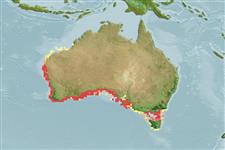Environment: milieu / climate zone / depth range / distribution range
Écologie
marin; saumâtre démersal; profondeur 1 - 30 m (Ref. 9563). Subtropical; - 45°S
Eastern Indian Ocean: known only from southern Australia, from Western Australia to Victoria and Tasmania. Large adults have been misidentified as Platycephalus fuscus, the common estuarine flathead of New South Wales and southern Queensland (Ref. 9563).
Length at first maturity / Taille / Poids / Âge
Maturity: Lm 32.5 range ? - ? cm
Max length : 90.0 cm TL mâle / non sexé; (Ref. 9563)
Description synthétique
Clés d'identification | Morphologie | Morphométrie
Épines dorsales (Total) : 8 - 9; Rayons mous dorsaux (Total) : 13 - 14; Épines anales: 0; Rayons mous anaux: 13 - 14; Vertèbres: 27. Adults have 3-5 large round black spots with white margins on the lower-half of the caudal fin.
A shallow water species, recorded from surf beaches, estuaries and in bays (Ref. 9563).
Paxton, J.R., D.F. Hoese, G.R. Allen and J.E. Hanley, 1989. Pisces. Petromyzontidae to Carangidae. Zoological Catalogue of Australia, Vol. 7. Australian Government Publishing Service, Canberra, 665 p. (Ref. 7300)
Statut dans la liste rouge de l'IUCN (Ref. 130435)
Menace pour l'homme
Harmless
Utilisations par l'homme
Pêcheries: sans intérêt
Outils
Articles particuliers
Télécharger en XML
Sources Internet
Estimates based on models
Preferred temperature (Ref.
123201): 15.7 - 23.8, mean 18 °C (based on 215 cells).
Phylogenetic diversity index (Ref.
82804): PD
50 = 0.5000 [Uniqueness, from 0.5 = low to 2.0 = high].
Bayesian length-weight: a=0.00525 (0.00246 - 0.01120), b=3.04 (2.85 - 3.23), in cm total length, based on LWR estimates for this (Sub)family-body shape (Ref.
93245).
Niveau trophique (Ref.
69278): 4.0 ±0.4 se; based on diet studies.
Generation time: 3.3 (2.5 - 4.4) years. Estimated as median ln(3)/K based on 11
growth studies.
Résilience (Ref.
120179): Milieu, temps minimum de doublement de population : 1,4 à 4,4 années (tm=1-2; tmax=12).
Fishing Vulnerability (Ref.
59153): Low to moderate vulnerability (35 of 100).
Nutrients (Ref.
124155): Calcium = 129 [10, 478] mg/100g; Iron = 1.84 [0.49, 4.79] mg/100g; Protein = 18.4 [16.1, 20.6] %; Omega3 = 0.299 [0.133, 0.836] g/100g; Selenium = 46.7 [12.9, 165.9] μg/100g; VitaminA = 7.74 [3.19, 18.47] μg/100g; Zinc = 0.841 [0.391, 1.706] mg/100g (wet weight);
